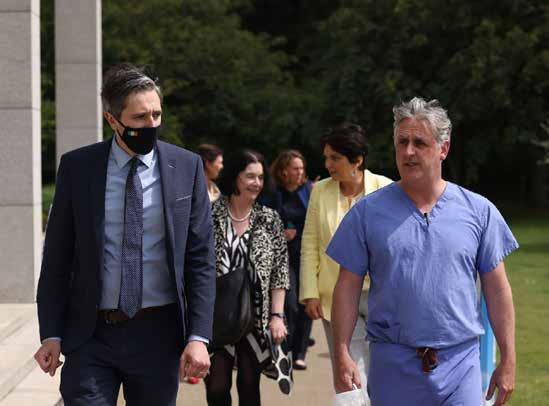
12 minute read
Focus on International Epilepsy Day
22
Epilepsy A focus on epilepsy for International Epilepsy Day 2022!
In advance of International Epilepsy Day 2022 on the 14th of February, I was delighted to be contacted by the Hospital Professional News editorial team to provide an update to you about Epilepsy Ireland’s plans for the day – and to give a general update on topics which may be of interest to readers of Hospital Professional News that could assist in your professional lives. On the behalf of everyone at Epilepsy Ireland, we would like to put on record our thanks to everyone involved in hospital services for your service over the last two years. The dedication and service of frontline workers across Ireland has been a constant throughout this pandemic and while I know that times remain challenging, we felt it wholly appropriate to outline our thanks to you all at the outset of this article.
Our team here at Epilepsy Ireland have fielded many questions about COVID-19 and epilepsy and the potential impact of vaccination on persons with epilepsy. For those of you who may have patients with epilepsy, I want to highlight that there is a direct information resource on our website www. epilepsy.ie addressing many of the common questions which are being received. Please feel free to visit the site and use the resources in working with your patients. One key question we have received is whether a person with epilepsy will be more susceptible to catching the virus due to their condition. The answer here is that there is no known evidence to suggest people with epilepsy are at higher risk of catching the virus. Another key question has been around whether a person with epilepsy will be more adversely affected should they unfortunately contract COVID-19. Again, there is no evidence to suggest that people with epilepsy are more adversely affected by the virus in terms of developing severe infection which may lead to hospitalisation or death. However, we have highlighted throughout the pandemic how the virus could have an impact on their existing condition – i.e, their epilepsy. This is because in most cases the virus comes with a temperature and a temperature in a person with epilepsy could reduce the person’s seizure threshold. This could therefore lead to a breakthrough seizure which could lead to a deterioration in seizure control; social implications through the loss of a driving license; and it should not be forgotten that a seizure can be life-threatening in cases. The life-threatening nature of epilepsy is something that can often come as a surprise to the wider public when discussing the condition. However, this is unfortunately a reality of epilepsy. The public can be particularly surprised when we discuss Sudden Unexpected Death in Epilepsy (SUDEP). SUDEP is a rare but devastating aspect of epilepsy and approximately 21-44 people with epilepsy pass away due to SUDEP each year in Ireland. Discussing SUDEP with people with epilepsy and their families can be a difficult conversation for healthcare professionals to have as there is so much we don’t know about this aspect of the condition. However, at Epilepsy Ireland, we prefer to focus on what we do know. We know that the better a person’s epilepsy is controlled, the less a risk of SUDEP. We know that the better a person’s epilepsy is managed (knowing triggers, taking medication as directed etc), the less of a risk about SUDEP. Crucially, we also know that people with epilepsy in Ireland want to
Written by Paddy McGeoghegan, Epilepsy Ireland Advocacy & Communications Manager
know about SUDEP – whether they are deemed as being high risk or not. In the past, SUDEP was often something that was not widely discussed but attitudes are changing. In a 2020 survey we conducted, it was found that 81% of people with epilepsy wanted to know more about SUDEP and that they wanted to hear about it early in their diagnosis with the condition – preferably from their consultant. For healthcare professionals, knowing when to talk to a patient about SUDEP can be difficult but it is a conversation that most people with epilepsy want to have. Again, we have an information resource on www.epilepsy.ie about SUDEP and if you have direct contact with patients with epilepsy, please do take the time to visit it and learn more.
With our contact with people with epilepsy and their families across Ireland, what is communicated to us daily is the importance of the public knowing what to do in the event of someone having a seizure – which brings us nicely into what the focus of our International Epilepsy Day campaign will be. Last year, in a survey of 1,000 members of the Irish public, 9 out of 10 respondents completely underestimated the prevalence of epilepsy in Ireland – believing it to be quite rare. The reality is that there are 40,000 people living with the condition around Ireland with approximately 2,000 new diagnoses every year. The condition is far from rare and is actually one of the most common neurological condition in the country.This is why it is vitally important the public know what to do in the event of a person having a seizure as there are people within their family, friend group and workplace who may be living with epilepsy. However, seizure first aid is often misunderstood as being quite complex and this is not helped by the fact that there are longheld myths about the seizure first aid when it comes to helping someone having a seizure. These include the belief that you must

of people with epilepsy living in Ireland show, this is information that the public needs to know – you never know when they might need to use it. Any support which the readers of Hospital Professional News can give us would be warmly received and appreciated. Finally, I would like to remind readers that Epilepsy Ireland is here to assist and support people with epilepsy and their families on their journeys with the condition. Our 11 Community Resource Officers cover the entire country and each represent different regions so if you feel a patient may benefit from their support, please do not hesitate to put them in touch with us.
Likewise, should our organisation be of assistance to you in your professional or personal life, please do get in touch. I can be contacted by emailing pmcgeoghegan@epilepsy.ie. Thank you for reading and I hope that this provided some insight on these topics for you. Keep your eyes peeled for the launch of our campaign on International Epilepsy Day on February 14th!
put something in a person’s mouth during a seizure to prevent them from swallowing their tongue; that there is only one type of epileptic seizure; and that a person should be restrained or pinned down during a seizure. As noted, all of these are myths! Thankfully, our survey from 2021 showed that these beliefs are deteriorating but the fact that these myths have existed for so long, means there is still much work to do in terms of public education. Because of these myths, we have often been in the position of talking more about what not to do rather than what to do when we’re discussing seizure first with the public. For this year’s International Epilepsy Day campaign, we will be reinforcing key seizure first aid messaging which we developed last year in an effort to overcome the belief that seizure first aid is complex and to dispel the myths associated with seizure first aid. This message boils down to three key words: TIME – SAFE – STAY. TIME – if you encounter a person having a seizure, the first thing you should do is begin timing that seizure. This is because if it goes over 5 minutes, it is potentially dangerous for the person and an ambulance will need to be called. SAFE – keep the person having a seizure SAFE. Cushion their head if possible and remove any harmful objects from around their vicinity but never restrain them, pin them down or put anything in their mouth.
STAY – after the seizure has ended, STAY with that person. Often after a seizure, a person will be dazed, confused and exhausted. Talk gently and stay with them until you know they are ok.
With the key messages of TIME – SAFE – STAY that we will be delivering to the public as part of our International Epilepsy Day campaign, what we are seeking to do is create a key memorable message in an epilepsy context – taking inspiration from “Act FAST” in response to a stroke and “Staying Alive” in response to a cardiac arrest.
We would appeal to readers of Hospital Professional News to please help us in advance of Epilepsy Day and on the Day itself to reinforce this key message of TIME – SAFE – STAY amongst the Irish public. We want to make sure that everyone knows what to do in the event of a person having a seizure and as the large numbers

PRESCRIBING INFORMATION (PI)
SKYRIZI®▼ (risankizumab) 75 mg solution for injection
in pre-filled syringe; Skyrizi 150 mg solution for injection in pre-filled pen and Skyrizi 150 mg solution for
injection in prefilled syringe. Refer to Summary of Product Characteristics (SmPC) for full information before prescribing. PRESENTATION: Skyrizi 150 mg solution for injection in pre-filled pen/syringe: each prefilled pen/syringe contains 150 mg risankizumab in 1 mL solution. Skyrizi 75 mg solution for injection in pre-filled syringe: each pre-filled syringe contains 75 mg risankizumab in 0.83 ml mL solution. INDICATION: For treatment of moderate to severe plaque psoriasis in adults who are candidates for systemic therapy. DOSAGE AND ADMINISTRATION: Intended for use under guidance and supervision of a physician experienced in diagnosis and treatment of psoriasis. Dosage: The recommended dose of Skyrizi is 150 mg by subcutaneous injection at weeks 0, 4, and every 12 weeks thereafter. Two 75mg pre-filled syringes should be injected for the full 150 mg dose. Consider discontinuation of treatment in patients showing no response after 16 weeks of treatment. Some patients with initial partial response may subsequently improve with continued treatment beyond 16 weeks. Special Populations: Elderly: No dose adjustment required. Renal or hepatic impairment: No dose adjustment required. Paediatric Population: No data available. Overweight patients: No dose adjustment required. CONTRAINDICATIONS: Hypersensitivity to any of the active substances or excipients. Clinically important active infections (e.g. active tuberculosis). SPECIAL WARNINGS AND PRECAUTIONS: See SmPC for full details. In order to improve the traceability of biological medicinal products, the name and the batch number of the administered product should be clearly recorded. Skyrizi may increase the risk of infections. In patients with a chronic infection or history of recurrent infections, or known risk factors for infection, Skyrizi should be used with caution. Treatment with Skyrizi should not be initiated in patients with any clinically important active infection until the infection resolves or is adequately treated. Patients should be evaluated for tuberculosis infection prior to initiating treatment. Anti-TB therapy should be considered prior to initiating Skyrizi in patients with a past history of latent or active TB in whom an adequate course of treatment cannot be confirmed. Completion of all appropriate immunisations should be considered prior to initiating therapy. If a patient has received live vaccination (viral or bacterial), it is recommended to wait at least 4 weeks prior to starting treatment with Skyrizi. Patients treated with Skyrizi should not receive live vaccines during treatment and for at least 21 weeks after treatment. If a serious hypersensivity reaction occurs, administration of Skyrizi should be discontinued immediately and appropriate therapy initiated. Excipients with known effect (75 mg solution for injection only): Skyrizi contains 68.0 mg sorbitol and less than 1 mmol sodium (23 mg) per 150 mg dose. INTERACTIONS: The safety and efficacy of Skyrizi in combination with immunosuppressants, including biologics or phototherapy have not been evaluated. PREGNANCY AND LACTATION: Women of Childbearing potential: An effective method of contraception during treatment and for at least 21 weeks after treatment should be used. Pregnancy: Limited data available. It is preferable to avoid the use of Skyrizi during pregnancy as a precautionary measure. Lactation: It is not known whether Skyrizi is excreted in breast milk. Human IgGs are known to be excreted in breast milk during the first few days after birth, which decreases to low concentrations soon afterwards; consequently, a risk to the breast-fed infant cannot be excluded during this short period. A decision should be made whether to discontinue/abstain from Skyrizi therapy, taking into account the benefit of breast-feeding to the child and the benefit of Skyrizi therapy to the woman. Fertility: The effect of Skyrizi on human fertility has not been evaluated. ADVERSE REACTIONS: See SmPC for full details on adverse reactions. Very common adverse reactions (≥1/10): Upper respiratory infections. Common adverse reactions (≥1/100 to <1/10): Tinea infections, headache, pruritus, fatigue and injection site reactions. ▼ This medicinal product is subject to additional
monitoring. This will allow quick identification of new safety information. Healthcare professionals are asked to report any suspected adverse reactions via HPRA Pharmacovigilance; Website: www.hpra.ie. Suspected adverse events should also be reported to AbbVie Limited on 01-4287900.
LEGAL CLASSIFICATION: POM (S1A). MARKETING AUTHORISATION NUMBERS/PRESENTATIONS: Skyrizi 75 mg solution for injection in pre-filled syringe (Pack of 2 prefilled syringes): EU/1/19/1361/001; Skyrizi 150 mg solution for injection in pre-filled pen: EU/1/19/1361/002; Skyrizi 150 mg solution for injection in pre-filled syringe: EU/1/19/1361/003. Not all presentations may be marketed. Further information is available from: AbbVie Ltd., 14 Riverwalk, Citywest Business Campus, Dublin 24. DATE OF REVISION: May 2021 PI/1361/003


HRQoL, Health-Related Quality of Life; PASI, Psoriasis Area Severity Index. REFERENCES: 1. Gordon KB, et al. Lancet 2018; 392: 650661. 2. Ryan C et al. Poster presented at the 27th European Academy of Dermatology & Venerology (EADV) Congress 2018; September 12–16; Paris, France. Skyrizi® Summary of Product Characteristics, available on www. medicines.ie. High skin clearance matters to patients: Patients who achieve and maintain high levels of skin clearance (PASI 90-99 or PASI 100) have significantly better HRQoL than those with lower levels of skin clearance (PASI 75-89).2 Sustaining high skin clearance or complete skin clearance is associated with incremental and durable benefits in HRQoL and mental health of psoriasis patients.2


What means everything to the patient? The potential for nothing left on their skin.*

* Nothing on the skin: Defined as 75% achievement of PASI90 at Week 16 and ≥50% achievement of PASI 100 at Week 52 in UltIMMa-1 and UltIMMa-2.1









